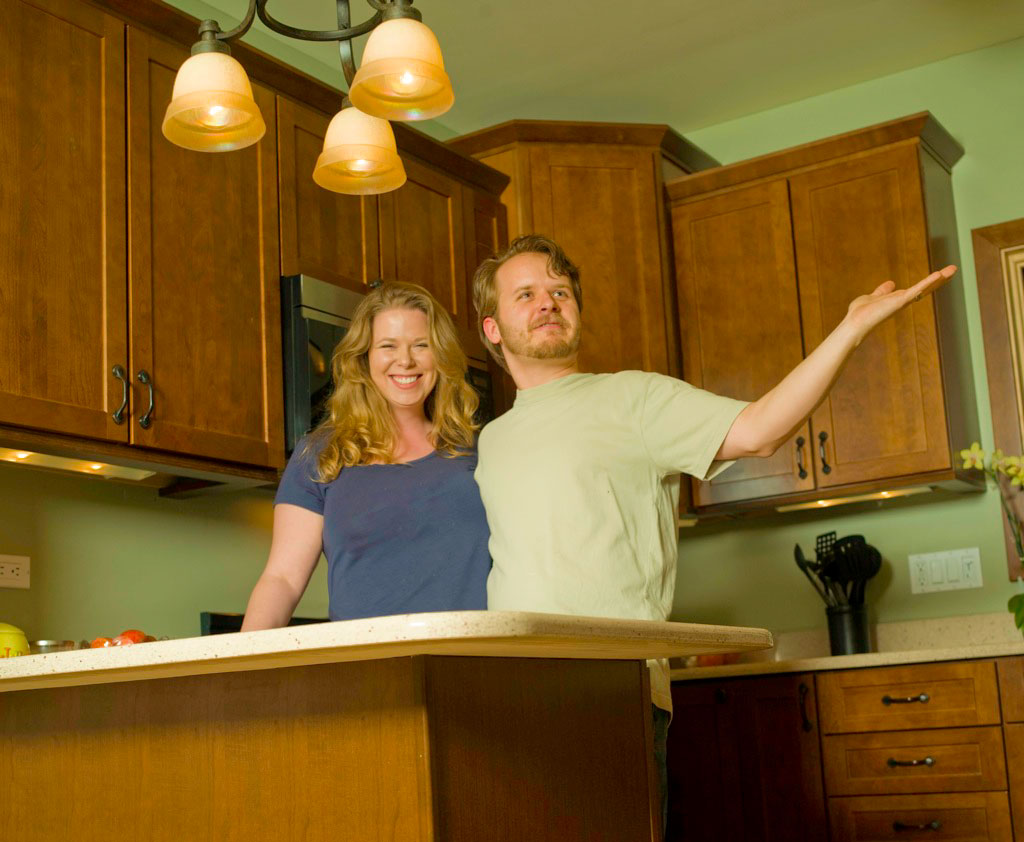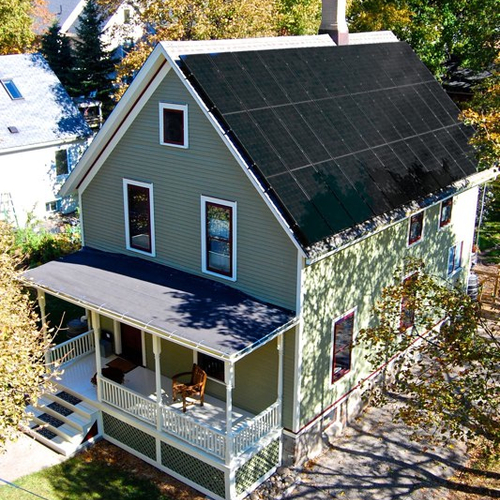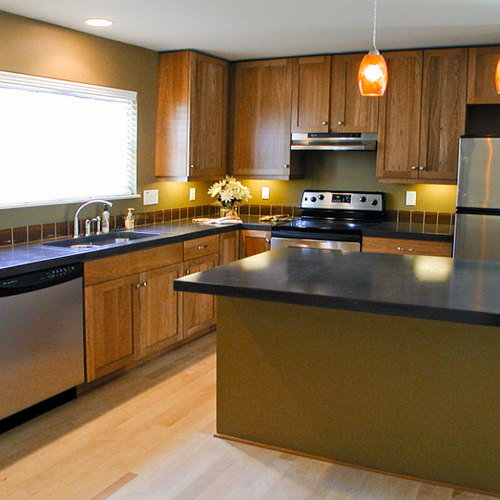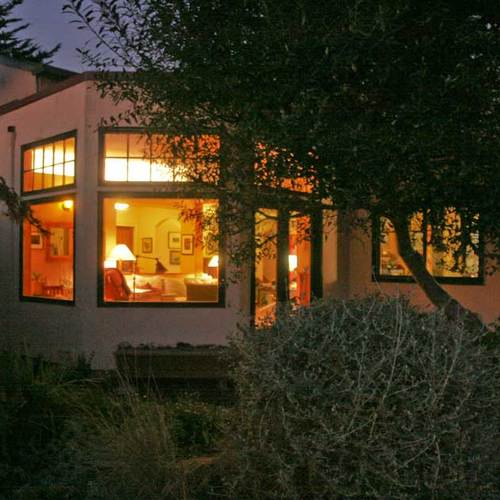
Image Credit: Jason La Fleur The home's porch had been enclosed with a screen that crumbled if you touched it with any amount of force, and indoor carpet had been installed over the exterior porch floor. Layers of paint were peeling over all exterior trim and other wood details.
Image Credit: Jason La Fleur The garage had not been painted since its construction in the 1950's although it had 3 layers of roofing on it, and the yard had been decimated by the previous owners two large dogs, as well as random acts of landscaping.
Image Credit: Jason La Fleur Jason La Fleur: "The built-in bookcases with art glass doors flanking a wood-burning fireplace are typical architectural details along with heavy wood trim found in many Oak Park craftsman-style homes, and are the raw features that sold us on the home."
Image Credit: Jason La Fleur Jason La Fleur: "The kitchen walls and ceiling had been furred out and covered by paneling when the last remodel took place (1953 according to one of the cabinets we removed). When we removed the paneling, we saw the original plaster chipping away, and realized the walls would need to be gutted."
Image Credit: Jason La Fleur The kitchen had a poor floor plan with 3 entrances in a 10 x 10 space, resulting in a poor work triangle, a hodgepodge of cabinetry, and outdated appliances. The walls had been "fixed" in the past by covering them with wood paneling.
Image Credit: Jason La Fleur Jason La Fleur: "We were fortunate to have a poured concrete foundation (rare for a 100-year old home) that matched the footprint above. The walls had been painted several times and there were clearly moisture issues we had to correct before we could transform the basement into a living space where we lived while work elsewhere on the home was completed."
Image Credit: Jason La Fleur Jason La Fleur: "On the sloped roof areas, we added foil-faced foam on the interior side to increase comfort and reduce thermal bridging. The one foam piece that is different was the classic DIY mistake of not getting enough materials, and then having to make a supplemental run to get more."
Image Credit: Jason La Fleur Jason La Fleur: "Since there were some moisture problems in the basement, when insulating we went with foam board below grade and fiberglass batts above grade. Unfortunately one of my biggest regrets was not knowing enough at the time to better insulate the rim joists here which have since been sealed off with drywall as we turned the basement to finished space that we lived in while converting the attic."
Image Credit: Jason La Fleur Jason La Fleur: "As we removed two doors from the first floor (kitchen and a former bedroom), we saved the door, jambs, and trim. We also sourced other vintage doors from Craigslist and the ReBuilding Exchange in Chicago for the new bedrooms and closets being built in the converted attic, giving the new space a more vintage feel. It was critical to do this first so we could frame the rough openings appropriately for each jamb. This probably saved over $1000 had we gone with new quality solid wood doors."
Image Credit: Jason La Fleur Jason La Fleur: "Being on a narrow lot with a 2-story home 8 feet from the southern facade means we don't get direct sunlight in the home. While nice in the summertime, we wanted more daylight during winter and put in a Velux suntunnel. In the dining room, the bay window gives the optical illusion that the sun tunnel must go right through our second floor living space, when in fact it is directly behind an attic kneewall. I like to call tubular skylights 'poor man's solar power'."
Image Credit: Jason La Fleur Most of the home's existing wall cavities would be filled easily with dense packed dry cellulose from the attic as the house was balloon-framed with continuous stud bays from foundation to the attic. Problem areas that required some interior coring and filling were the bay windows in the Living Room.
Image Credit: Jason La Fleur This in-progress photo shows not only where the bathroom layout would be, but also the 2x6 sistered floor joists and the small bit of rockwool insulation that had originally been in the 1912 home, serving as "ceiling insulation".
Image Credit: Jason La Fleur Jason La Fleur: "To seal and insulate the kitchen we chose a closed-cell soy-based spray foam insulation, in part because the breakfast nook off the kitchen, while original, was over a crawl space and had five sides exposed to the outdoors. The exhaust fan ducted to outdoors was to deal with the temporary high humidity created by the water-blown spray foam."
Image Credit: Jason La Fleur Jason La Fleur: "After removing a wall, we were lucky to find both rooms had originally had maple floors installed. But the floor needed to be patched where the wall had been, and reclaimed maple flooring from a high-school gymnasium was used in the patch. Once sanded, the floors transitioned nicely."
Image Credit: Jason La Fleur Jason La Fleur: "It's important during any demolition to segregate out wood and metals for diversion. Living in an urban area with an alley meant any metal could be placed in back and would be picked up by scrap metal haulers within a day or two. We reused any studs for new framing, saved remaining clean wood for firewood, and used quite a bit a lathe for for Halloween decorations to make a decrepit fence (we really get into this holiday), creating a screen / garden trellis, and for firewood." Jason La Fleur: "Installing a large window in our new kitchen / family room area quickly made us realize that we did not have much privacy from the alley and three story multifamily buildings on the other side. So one creative use of the old lathe that I salvaged was making a unique 4-foot wide prairie-influenced screen that doubles as a garden trellis during summer. I created the design myself, taking cues from the new exterior door we installed, and trying to have a floral motif along each vertical framing member (which are spaced 16" on center). The result was much better than I envisioned."
Image Credit: Jason La Fleur Jason La Fleur: "The original garage siding was not significant and was a maintenance issue so we went the affordable route and resided it with vinyl siding. A pleasant surprise was a brighter yard as this lighter color reflected much daylight into our narrow back yard."
Image Credit: Jason La Fleur Jason La Fleur: "The basement as it looked upon completion (right before the holidays). We moved into the basement shortly after this as work began to convert the attic into two bedrooms and a bathroom. The glass block windows end up reflecting in a lot of daylight and makes the partially below grade space feel much homier than you would expect from a basement."
Image Credit: Jason La Fleur Image Credit: Jason La Fleur Jason La Fleur: "The finished living room has newly painted walls and a wonderful natural oil finish using Rubio Monocoat. At some point we may change the fireplace, but for now we painted over the old white paint with a nice rich gray that complements the room much better."
Image Credit: Jason La Fleur Jason La Fleur: "One of my more favorite projects was eliminating the turfgrass in the front yard and replacing it with a native and drought-tolerant landscape design. This yard is now in its first full year (just established last year), and is filling in beautifully."
Image Credit: Jason La Fleur Jason La Fleur: "Knowing we wanted to create a dormered master bath required thinking structurally from the beginning. We had to make sure the loads would be carried to the foundation, and also beef up the converted attic floors. We ended up sistering 2x6 LVL to the existing 2x6 joists throughout the second floor to give a solid weight distribution."
Image Credit: Jason La Fleur Existing plan.
Image Credit: Jason La Fleur Foundation plan showing new walls (created under main wood beam to help support dormer addition).
Image Credit: Jason La Fleur This is the 1st floor renovation plan.
Image Credit: Jason La Fleur Second floor plan showing converted attic bedrooms and new bathroom. Shed dormer is circled (it required a zoning variance due to setback).
Image Credit: Jason La Fleur
Jason La Fleur, Regional Director at the Alliance for Environmental Sustainability, explains how remodeling his 1912 Oak Park Arts and Crafts home led to his new career in green building
In 2004, Jason La Fleur and his wife Jennifer bought a classic Arts and Crafts home in Oak Park, Illinois, home to the largest single collection of buildings designed by Frank Lloyd Wright. It was quite a find: a single family home, modestly priced, in an outstanding neighborhood — and not too much of a “fixer-upper.” While they had a couple of discrete renovation projects they knew they wanted to do shortly after moving in, they had no idea how their work on their “Humphrey House” would transform much more than just their home.
A teacher goes on a learning tear
Jason knows a lot about learning; he has a Masters in Education and worked for several years developing curriculum for the real estate appraisal industry.
“I knew a bit about buildings,” says Jason, “and knew I would need to learn a lot more when we started to work on our house. But the Humphrey House literally threw me into green building right off the bat. Our walls had no insulation, construction dumpsters seemed full of recyclable materials, and there were dozens of methods and materials for us to consider to reduce our water and energy bills.”
So Jason not only spent seven years going room by room to make their home a greener one, he managed to also become a USGBC LEED-accredited professional, a Green Rater, and is now a Regional Director for the Alliance for Environmental Sustainability. “I completely hold my house responsible for becoming so involved in green building,” quips Jason.
Green building transforms the Humphrey House renovation plans
Jason and Jennifer had planned to just add a bath and dormer upstairs and accomplish some kitchen upgrades and a facelift. But the green building approach kept pulling their projects deeper and deeper into performance and integration.
“Green building is difficult to dabble in,” Jason shares. “When you become aware of the connections between energy and water efficiency, indoor air quality and material selections, it forces a more comprehensive and frankly smarter approach to remodeling your home. Heck, we ended up mostly living in our basement for more months than we care to admit as we fit the pieces together for green renovation room-by-room.”
All this starts to sound like project creep and a busted budget. But Jason is quick to point out that many green aspects of their project SAVED them money: salvaged flooring, trim, and interior doors; reused framing; reduced tipping fees with lots of recycling and less disposal; and a minimalist approach to landscaping. “Holding our budget for the total project to just $56 per square foot is a lot about doing nearly 70% of the labor ourselves, but going green either saved us money or helped us hold the line there,” Jason states with complete confidence. “Better yet, we’ll have a more comfortable home with lower operating expenses going forward.”
As the couple gained more green building knowledge, performance testing entered the mix. In 2009, they conducted a blower-door test that was invaluable in buttoning up the house. The resulting corrections and air sealing have made the 100-year old home much more comfortable, and after these improvements there was a drop in their utility bills even though the number of people in the household increased (see sidebar Energy Specs).
Moving from cost to value
While Jason and Jennifer stretched themselves quite a bit financially to get the Humphrey House, it was the total value that drove them. Jason explains: “Oak Park is not just a beautiful community. It has three train lines into Chicago, it’s family friendly, and both Jennifer and I can walk to work.”
And Jason knows a bit about home valuation; remember his work with real estate appraisers. “Some of the value that green building adds to residential properties is starting to be reflected in home appraisals with the help of the Chicago region’s Green MLS features,” says Jason. “Creating that database infrastructure is critical for an appraiser to be able to identify what a local market is willing to pay for green improvements. Only then can the appraisal industry fully capture added green value in order for green building to thrive. This is particularly challenging in the existing home market.”
Green appraisals and GAPScore
The appraisal industry is not particularly well known for its rapid movement toward adding green valuation to their methods and materials. But Jason played an early role in the development of a new Appraisal Institute effort: the Valuation of Sustainable Buildings Professional Development Program. The program currently has two courses, Introduction to Green Buildings: Principles and Concepts and Case Studies in Appraising Residential Green Building. There are also some online education offerings such as Valuation of Green Residential Properties. Additionally, a recent The Appraisal Journal article, “Valuing High Performance Houses,” provides very specific methods for appraisers to employ to capture green value. (You can download this article from the Alliance for Environmental Sustainability’s Green Real Estate Toolkit.
Finally, a colleague of Jason’s, Steve Pohlman, has been hard at work developing GAPScore, the first green assessment test for existing single-family dwellings. “When I first got involved in green building, becoming a verifier for the National Green Building Certification program, I asked the question, ‘How green is my home?’” says Steve Pohlman. “And no one could tell me.” Jason La Fleur did a before-and-after GAPScore on Humphrey House, starting with a 29 (out of 100) and landing with a score of 49.2, making Jason’s home in the “light green” category — 46 to 70 — or “above average” (See Certification sidebar). “If GAPScore catches on and we get a critical mass of existing homes scored in different neighborhoods and markets, that can be pretty useful to home buyers AND appraisers, right?” Steve asks.
GAPScore is a novel and innovative approach to the green valuation issue for existing homes, and it will be interesting to see how it relates to rating programs for existing homes, such as LEED for Homes (gut rehabs), NGBS-rated projects, and the new DOE Home Energy Score program.
GAPScore_HumphreyHouse-postremodel.pdf
Weekly Newsletter
Get building science and energy efficiency advice, plus special offers, in your inbox.
Lessons Learned
This is an easy topic for Jason: “We had a ton of them! It’s the classic case of ‘If only I knew then what I know now.’”
Spray foaming the entire converted attic: “We went at this with batts and rigid insulation; spray foam would have given us a much tighter lid on our house.”
Using salvaged vintage doors: “They look great and fit the existing architecture and style of our home, and they cost far less than comparable new interior doors.”
Remodeling room by room, learning green on the go: “We missed quite a few opportunities for integrated design and integration of our construction work overall.”
Jason wraps up the Lessons Learned discussion this way:
“If I had to do it all over again, I probably would look at purchasing a home in much worse condition, such as a foreclosure, which would make it that much easier to take a comprehensive approach to gut rehabbing. Ironically, next time I’d also involve a contractor, rather than doing the work myself piecemeal over time. While there would be a higher upfront cost, a lower acquisition price and the significant savings in my own time and effort, coupled with the opportunity for better results would have made it worthwhile.
“And finally, I would have pursued a performance-based third-party green certification such as LEED, so that at some point in the future when we go to sell this home, the home’s green improvements will be easily recognized by a future buyer, and fully valued by their lender and appraiser.”
General Specs and Team
| Location: | Oak Park, IL |
|---|---|
| Bedrooms: | 4 |
| Bathrooms: | 3 |
| Living Space: | 3135 |
| Cost: | 56 |
| Additional Notes: | Total cost does not reflect the labor supplied by the owner's family or friends. The builder estimates that approximately 70% of the total labor on the project is not reflected in the cost per square foot cited above. The square footage total includes the entire basement (home was originally 1785 square feet). |
Builder: Jason La Fleur, EcoAchievers
Construction
(Home originally built in 1912)
Foundation: Original basement poured concrete foundation; 1.5” XPS foam board exterior / 1” XPS foam board interior
Walls: Original 2x4: some blown-in cellulose / some with BioFoam soy-based closed cell spray foam
Roof: Original roof (had been tear-off 10 years ago), insulated with John Mansville formaldyhde-free fiberglass to R-19, with 1” XPS on interior below drywall
Windows: Combination of Andersen awning window, Pella double-hung and casement windows, Marvin double-hung, and Serious Windows double-hung. U-factors range from .32 to .20
Garage: Detached
Energy Specs
Blower door test results: 9.4 ACH50 (during; final results pending)
Domestic water heating: Takagi TK2
Total Household Energy Consumption - 2008: 179,542,604 Btus
Total Household Energy Consumption - 2010: 148,264,020 Btus
Note: 2011 total, after all energy-saving retrofits, pending
Water Efficiency
Toilets: Kohler WaterSense
Faucet aerators: Niagara
Rain barrels: Chicago Metropolitan Water Reclamation District
Indoor Air Quality
Interior floor finish: Rubio Monocoat
Ventilation: Panasonic kitchen and bath exhaust fans (previously none)
Garage: Detached
Certification
GAPScore (before): 29
GAPScore (after): 49
GAPScore documentation for Humphrey House - Post-remodel











0 Comments
Log in or create an account to post a comment.
Sign up Log in